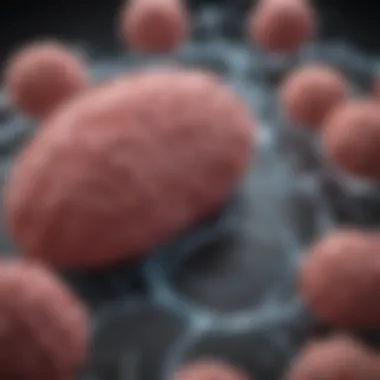Protein's Impact on Reducing Belly Fat


Intro
In today’s fast-paced world, where health trends continuously shift like sand underfoot, the quest for effective weight management remains a priority for many. A frequent conversation starter among nutritionistas and fitness buffs is protein's role in reducing that pesky belly fat. This article takes an insightful look at how integrating protein into one’s diet can be more than just a means to bulk up; it can be a pivotal component in a comprehensive strategy to trim unwanted fat.
Our bodies are intricate machines. Just like a car motor needs quality fuel to run smoothly, our bodies require the right nutrients to function optimally. Protein often gets a spotlight in nutrition discussions, but why exactly is it crucial when we talk about losing belly fat? The thirst for knowledge about protein’s biochemical implications and its effect on body composition helps reveal its multifaceted contributions to weight loss.
As we explore the significant nuances of dietary protein and its benefits in our battle against belly fat, we aim to provide evidence-backed insights into both practical advice and the science behind it. From various sources of protein to its metabolic influences, this article will shine a light on how integrating protein effectively can turn the tide in the quest for a healthier body composition.
Article Overview
Summary of Key Findings
Through a dive into recent research, there is a growing body of evidence that supports the benefits of dietary protein as it relates to fat loss, notably in the abdominal area. Some of the key findings outline the role of protein in:
- Increasing Satiety: Protein consumption tends to enhance feelings of fullness more effectively than carbohydrates or fats, thus curbing overall calorie intake.
- Preserving Lean Muscle Mass: During weight loss phases, high protein intake ensures that muscle loss is minimized, which is crucial for maintaining metabolic rates.
- Boosting Metabolism: Protein has a higher thermic effect than fats and carbohydrates, meaning it requires more energy for digestion, translating to increased calorie expenditure.
This improving understanding underscores a vital aspect of nutrition for weight loss, making protein a cornerstone of dietary adjustments.
Research Objectives
The primary objectives of this exploration are:
- To elucidate how protein influences fat loss specifically around the belly area.
- To investigate different dietary sources of protein and their varying impacts on body composition.
- To share practical dietary recommendations that readers can integrate into daily life to optimize fat loss and body health.
By understanding these facets thoroughly, individuals can make informed decisions regarding their diet and lifestyle, equipped with knowledge that resonates beyond simple calorie counting.
Key Results and Discussions
Main Findings
A closer analysis reveals that not all proteins are created equal. For instance, lean meats like chicken, fish, and plant-based options such as lentils and quinoa play varying roles in influencing body composition. Whey protein, often favored by sports enthusiasts, is particularly noted for its efficacy in muscle retention and fat loss when compared to other sources.
Interestingly, some scientific studies suggest that timing, alongside type, influences these outcomes. Consuming protein throughout the day rather than in one sitting may maximize its benefits to satiety and lean mass preservation.
Implications of Findings
The implications of integrating sufficient protein into one’s diet are profound. Not only does it align with the physiological needs for weight management, but it can also pave the way for healthier lifestyle choices. Individuals embracing this understanding may find themselves making smarter dietary choices, leading to sustained weight loss and improved overall health.
“A balanced understanding of protein's role can be a game-changer for those aiming to lose belly fat,” says Dr. Jane Doe, a leading researcher in nutritional science.
As we synthesize the insights presented, it becomes apparent that the relationship between protein intake and belly fat reduction is one worth respecting. It not only highlights the need to prioritize quality protein in a balanced diet but also provides a framework for actionable strategies that facilitate a healthier, leaner physique.
Ultimately, by spotlighting protein’s myriad attributes, this exploration offers invaluable guidance for those walking the path to better health.
Preamble
In recent years, the quest for effective weight management, particularly concerning belly fat, has garnered significant attention. This is not just a cosmetic concern, but a critical health issue. Reducing belly fat can have profound implications for one's overall health, influencing the risk of serious conditions, including heart disease and diabetes. Many people are on the lookout for strategies that work, and here comes the spotlight on protein.
So, why focus on protein? Well, protein plays a multi-faceted role in our diets and how our bodies process food. It affects not just how full we feel but also how effectively we burn calories. When it comes to curbing belly fat, the stakes are high, and the benefits are numerous.
By incorporating sufficient protein into meals, individuals may experience increased satiety, which could lead to reduced overall caloric intake. Additionally, protein helps preserve lean muscle mass during weight loss, which is crucial, as a leaner body may actually burn more calories at rest. In essence, a high-protein diet can kickstart a beneficial cycle in managing weight.
Moreover, exploring the different sources of protein—be it animal or plant-based—opens up a wealth of dietary possibilities. Each offers distinct advantages and nutrient profiles that can complement various dietary strategies.
As we delve into this topic, it's crucial to grasp the underlying mechanisms of how protein promotes fat loss, along with practical applications that can be seamlessly integrated into daily life. This understanding not only aids individuals in their personal health journeys but also equips educators and professionals with evidence-based insights to share with students and clients.
Ultimately, the intersection of protein consumption and belly fat reduction is a compelling subject that holds the promise of revealing substantial benefits for those willing to make informed changes. Exploring this role fully will illuminate paths toward a healthier and more balanced lifestyle.
Understanding Belly Fat
Understanding belly fat is crucial for anyone venturing into the complex landscape of weight loss and health improvement. This excess fat around the abdomen can be more than just an aesthetic issue; it plays a significant role in overall health. Particularly given its association with various diseases, recognizing the types of belly fat and their health implications can guide effective strategies for reduction.
Types of Fat
Belly fat primarily encompasses two kinds: visceral fat and subcutaneous fat. Knowing the difference between these can provide insights into how they each interact with your body and metabolism.
Visceral Fat
Visceral fat is often deemed the more dangerous variant due to its location deep within the abdominal cavity, surrounding important organs like the liver and pancreas. One key characteristic of visceral fat is its metabolic activity. Unlike other fat types, this fat can release inflammatory substances that may lead to serious health issues.
- Why it matters: Individuals with high levels of visceral fat are at a heightened risk for chronic diseases such as heart disease, cancer, and diabetes.
- Unique feature: Unlike subcutaneous fat, which sits just beneath the skin, visceral fat is hidden and can be quite deceptive. People may look slim but still carry a harmful amount of visceral fat inside.
This hidden fat is not just a cosmetic issue; it poses significant health risks that make it a prevalent focus when assessing body composition and health.
Subcutaneous Fat
In stark contrast, subcutaneous fat is that which sits directly under the skin. It’s the type of fat that you can pinch, and while it often gets a bad rap, it is not all doom and gloom.
- Why it matters: This fat type serves protective functions, cushioning your organs and helping to regulate body temperature.
- Unique feature: In terms of aesthetics, losing subcutaneous fat can lead to noticeable changes in appearance can help boost self-esteem.
However, excessive subcutaneous fat can be an indicator of overall higher body fat percentages, linking it to health concerns, though it is less harmful than its visceral counterpart.


Health Implications of Belly Fat
When you start looking at belly fat seriously, it’s eye-opening to see how it is intertwined with various health risks. The implications stretch far beyond vanity concerns; they root deeply in the realm of metabolic health.
Cardiovascular Risk
The health risks associated with belly fat cannot be understated, particularly when it comes to cardiovascular health. High levels of belly fat have been linked to an increased risk of heart disease. This is partly due to inflammation and other harmful substances produced by visceral fat.
- Why it matters: Individuals with high abdominal fat tend to experience issues like high blood pressure and lipid imbalances.
- Unique feature: Belly fat does not merely impact heart health; it connects with a series of cardiovascular risk factors that can accumulate over time.
Type Diabetes
Type 2 diabetes is another pressing concern vividly connected to belly fat. The accumulation of fat around the abdomen can lead to insulin resistance, a key factor in the development of diabetes.
- Why it matters: Those with larger waist circumferences are often assessed for their risk of developing type 2 diabetes.
- Unique feature: Managing belly fat can significantly aid in lowering the risk or even reversing early symptoms of diabetes.
In summary, comprehending the types and health implications of belly fat is fundamental to devising strategies targeting fat reduction, particularly through dietary adjustments like increased protein intake. Little by little, the insights gained here can pave the way for informed decisions in the quest for better health.
The Science of Protein
Understanding protein is crucial for comprehending its impact on belly fat reduction. Proteins are not just building blocks but also play significant roles in various bodily functions. When it comes to fat loss, especially in the belly area, protein can be a formidable ally. It aids satiety, helps maintain muscle during weight loss, and even influences metabolic rates. This section explores the foundational elements of protein, primarily focusing on its components and biological roles.
What is Protein?
Amino acids
Amino acids hold a cherished position in the world of nutrition. These organic compounds form the basis of proteins and are vital for countless physiological functions. Of the 20 amino acids, nine are essential, meaning the body cannot produce them alone and thus must obtain them through diet. Amino acids contribute significantly to muscle repair and growth, making them especially valuable for anyone on a fitness journey aimed at reducing belly fat.
One critical aspect is their role in synthesizing neurotransmitters, which can indirectly affect hunger signals. The unique feature of amino acids is their ability to support not just muscle resilience but also overall metabolic health. Therefore, the inclusion of amino acids in one’s diet is not just advantageous; it is paramount for those looking to achieve effective fat loss strategies.
Protein structure
The structure of protein itself is equally fascinating. Proteins are made up of chains of amino acids that fold into complex shapes, which determine their functions. This structure can be categorized into four levels: primary, secondary, tertiary, and quaternary structures. Each level plays its part in defining how proteins interact within the body. Understanding protein structure is beneficial in this context because the shape affects how the body utilizes the protein for various functions, including muscle synthesis and metabolic processes.
What sets protein structure apart is the stability it lends to proteins. Different structural forms can influence how proteins function upon intake. Some forms may be more bioavailable than others, which can affect how effectively they promote satiety or play into muscle preservation during weight loss.
Biological Functions of Protein
Enzyme function
Enzymes are workhorses in the body, and proteins are the foundation upon which many enzymes are built. Essentially, enzymes catalyze biochemical reactions crucial for metabolism and digestion, meaning they help break down food and convert it into usable energy. Protein's role in this area is dynamic and foundational: without enzymes, many of the processes leading to effective fat loss would grind to a halt.
One key characteristic of enzyme function that benefits those pursuing fat loss is that enzymes are incredibly specific. Each enzyme allows specific reactions to occur more efficiently, creating a focused pathway for nutrients to be absorbed and utilized by the body. This specificity shows why understanding protein and enzymes can be a game-changer in dieting strategies aimed at lowering belly fat.
Hormonal regulation
Hormonal regulation through proteins is another significant contributor to fat loss. Proteins are involved in the creation of hormones that can affect appetite and metabolic rates. For example, proteins can influence the secretion of insulin or leptin, which are hormones tied to hunger and satiety. A well-regulated hormonal environment is essential for successful weight management.
The distinctive feature of protein-related hormonal regulation is its bi-directionality. Not only do proteins help regulate hormones, but they can also be influenced by them. This creates a feedback loop where protein intake can affect hormone levels that subsequently influence appetite and metabolism. It’s a cycle that exemplifies the intricate relationship between diet and body functions, especially concerning belly fat reduction.
“Integrating higher protein into your diet is not just about muscle gain; it’s about how you can steer your body’s biochemical pathways towards fat loss.”
In summary, a thorough understanding of protein, from its basic components to its nuanced roles in biological processes, provides a strong foundation for exploring its potential in reducing belly fat. Recognizing how amino acids, protein structure, enzyme functions, and hormonal regulation intertwine clarifies their relevance and applicability in dietary strategies aimed toward fat loss.
The Link Between Protein and Fat Loss
Understanding the link between protein and fat loss is crucial for anyone targeting belly fat reduction. By knowing how protein interacts with our body system, individuals can make informed dietary choices that not only help shed excess weight but also promote overall health. Increasing protein intake can support fat loss in multiple ways—it can boost metabolism, aid in muscle preservation, and improve satiety levels.
Mechanisms of Fat Loss
Thermic effect of food
The thermic effect of food (TEF) refers to the energy required for the digestion, absorption, and disposal of nutrients. Protein, in particular, has a high thermic effect, requiring about 20-30% of its calories to be expended during this process. This makes it a pretty decent option for anyone looking to lose fat. The higher energy expenditure associated with protein consumption means that the body burns more calories compared to carbohydrates or fats.
What's unique about this characteristic is that it creates an advantageous scenario for those trying to manage weight. When you consume protein-rich meals, your body goes into overdrive to break it down and utilize it, effectively giving you a little boost in the calorie-burning department. This can be most beneficial in a weight-loss journey, as it leverages the natural energy expenditure of the body against fat accumulation.
Satiety signaling
Satiety signaling refers to the biochemical processes that inform the body when it has had enough to eat. Protein plays a significant role in enhancing feelings of fullness, which can be a game-changer in controlling food intake. Consuming protein-rich meals leads to the release of hormones like peptide YY and glucagon-like peptide-1, which signal to the brain that satiation has been achieved.
This characteristic makes protein a star player when strategizing to minimize belly fat. Since meals high in protein tend to keep hunger at bay for longer periods, one is less likely to overindulge or snack mindlessly. Incorporating an adequate amount of protein into your diet can thus contribute to managing caloric intake effectively, promoting fat loss.
Preservation of Muscle Mass
Muscle synthesis
Muscle synthesis refers to the process through which the body builds muscle tissues. Adequate protein consumption is vital for this process, especially during a calorie deficit. When aiming to lose fat, it is common for the body to shed muscle alongside fat. However, increasing protein intake can help mitigate this effect. The unique feature is that protein not only supports muscle recovery but also stimulates muscle growth.
Moreover, engaging in resistance training while consuming a high-protein diet can shift the balance in favor of muscle retention, even in the face of weight loss. This preservation is beneficial as more muscle mass correlates with a higher metabolic rate, which plays a role in continuous fat loss.
Impact on metabolism
The impact on metabolism involves how protein influences metabolic functions in the body. A higher protein intake can lead to an increase in resting metabolic rate (RMR), which refers to the number of calories the body expends at rest. This occurs because building and maintaining muscle requires more energy, which means that as effective protein intake increases muscle mass, the overall calorie burn can also go up.


One of the advantages here is that individuals who successfully increase their muscle mass also create an environment where fat loss is more achievable and sustainable. However, it’s essential to balance protein intake with overall caloric consumption to avoid unwanted weight gain.
By understanding these mechanisms, you can harness the potential of protein as a strategic ally in your battle against belly fat. Not only does it help with fat loss, but it also supports a healthier lifestyle overall.
Protein and Dietary Strategies
In the quest to lessen belly fat, the role of dietary strategies featuring protein cannot be overstated. These strategies stem from understandings of how protein interacts with metabolism, hunger, and body composition. When embraced, high-protein diets can be a game-changer, providing a pathway for individuals to not only reduce their waistlines but also maintain viable muscle mass during weight loss.
High-Protein Diets
Types of high-protein diets
High-protein diets come in various forms, each having unique characteristics that appeal to different individuals and health goals. For instance, the Ketogenic diet, famous for its low-carb, high-fat, and moderate-protein composition, forces the body into a state of ketosis. This process can facilitate fat burning, particularly around the belly area. Meanwhile, the Paleo diet focuses on eating like our ancestors did, emphasizing whole foods and lean proteins. This approach eliminates processed foods, encouraging natural protein sources like chicken, fish, and untouched plants.
The appealing aspect of these diets is their simplicity and the immediate feedback many individuals experience as they feel fuller for longer, thanks to increased protein intake.
Research findings on effectiveness
Numerous studies bolster the efficacy of high-protein diets in achieving fat loss. One notable research, published in the journal Obesity, indicated that participants adhering to a high-protein plan not only lost weight but also demonstrated significant reductions in belly fat over 12 weeks. This characteristic of maximizing satiety while minimizing hunger pangs makes such diets quite beneficial. Blending protein with fiber-rich veggies can further amplify this effect, promoting sustained fullness and diverse nutrient intake.
However, it's also important to balance protein intake with other macronutrients for optimal health. Some individuals might experience digestive discomfort or nutrient deficiencies if the protein levels are excessively high without adequate fiber or healthy fats.
Incorporating Protein in Meals
Meal planning
Strategically planning meals around protein sources plays a crucial role in dietary success. Setting a roadmap for meals ensures that individuals are not merely reacting to hunger cues but actively making choices that align with their goals. For example, scheduling protein-dense breakfasts, like Greek yogurt topped with nuts, can jumpstart metabolism early in the day.
This meal planning enables a potent combination of proteins and other nutrients, allowing individuals to stay away from unhealthy snacking that leads to unnecessary caloric intake. Furthermore, meal preparations can save time and reduce the temptation to drop healthy eating habits when on the go.
Timing of protein intake
When it comes to timing, research suggests that spreading protein intake evenly throughout the day can be more effective than concentrating it in one or two meals. Consuming protein-rich foods within 30 minutes post-workout can significantly enhance muscle recovery and metabolism.
Incorporating protein across all meals can also help maintain steady blood sugar levels and stave off cravings. For example, have protein in the morning, a solid midday meal, and a protein-rich snack in the evening. Yet, balancing protein intake with carbohydrates and fats at each meal is essential for comprehensive nutrition.
Continuous study into the timing of protein intake shows promising results linking it to improved body composition. It’s all about finding the right rhythm that works for each individual.
Sources of Protein
When it comes to shedding belly fat, understanding protein sources is critical. Protein not only plays an essential role in muscle repair but also influences metabolism. The quality and type of protein consumed can significantly affect the body's ability to lose fat. Diverse sources provide different components that can aid in achieving dietary goals.
Animal-Based Proteins
Animal-based proteins are often praised for their high biological value, meaning they contain all essential amino acids. They are a go-to for many looking to cut fat while still maintaining muscle mass.
Meat sources
Meat sources are renowned for being a powerhouse of protein. These include chicken, beef, pork, and fish. One primary aspect to consider is their rich amino acid profile, especially protein like whey. It's particularly popular due to its rapid absorption. Another key point is saturation; meats typically bring a sense of fullness, assisting in regulating appetite. However, it’s crucial to be cautious with red meats as they may increase health risks if consumed in excess. Lean meats such as chicken breast can be a beneficial staple in a belly fat reduction strategy, helping to provide necessary proteins without excessive calories.
Dairy products
Dairy products like yogurt, cheese, and milk are also significant protein sources. Yogurt, particularly Greek yogurt, stands out with a high protein content and probiotics that aid digestion, enhancing gut health and possibly impacting weight management. One unique feature is the calcium present in dairy, which some studies link to fat reduction. However, many individuals have lactose intolerance, which can be a disadvantage for those looking to these products for protein intake. Being aware of personal dietary needs is crucial.
Plant-Based Proteins
Plant-based proteins are gaining traction, particularly among those seeking to lower fat intake. They offer diverse options, making them a fantastic addition to any diet aimed at reducing belly fat.
Legumes
Legumes such as lentils, chickpeas, and beans are not only high in protein but also fiber. This fiber contributes to prolonged satiety and can prevent overeating, aiding weight management. Plus, legumes are also relatively low in calories, making them a fantastic, healthy choice. The unique feature of legumes is their ability to improve gut health while offering plant-based protein benefits. However, they can be harder to digest for some, potentially causing discomfort if consumed in large quantities.
Nuts and seeds
Nuts and seeds, such as almonds, chia seeds, and flaxseeds, serve as another enriching source of protein. They are rich in healthy fats, making them a popular choice for adding something extra to meals or snacks. Their combination of protein, fiber, and healthy fats can keep hunger at bay. However, the caloric density of nuts means moderation is key; a handful can nudge up daily caloric intake quickly. Their appealing flavor and versatility make them an enticing option for achieving belly fat reduction goals.
"Choosing the right protein sources can significantly impact the body’s fat loss journey, influencing metabolism and satiety levels."
Assessing different protein sources is paramount for anyone serious about reducing belly fat. Both animal and plant-based proteins hold unique advantages and should be part of a well-balanced diet.
Challenges and Considerations
When discussing protein's potential to assist in reducing belly fat, it’s vital to recognize the challenges and considerations that accompany high protein intake. Understanding these nuances helps readers navigate the journey towards effective weight management with clarity and prudence. One cannot simply increase protein in their diet without addressing how it fits into the bigger picture of overall nutrition and lifestyle. These considerations span overconsumption concerns, caloric intake balance, and the importance of dietary quality.
Overconsumption of Protein
Potential health risks
Overdoing protein may seem like a smart move at first glance. Yet, it carries certain health risks that shouldn’t be brushed aside. For instance, excessive protein consumption can lead to kidney strain, particularly in individuals with pre-existing renal issues. Another concern is the potential for increased cardiovascular problems, especially when high-protein diets lean heavily on red and processed meat, contributing unhealthy fats. This aspect of potential health risks is crucial as it reminds us that more isn’t always better.
Protein intake ought to be balanced and tailored to individual health goals and conditions. A notable characteristic about these risks is that they aren't just theoretical—there's scientific backing. Research indicates that while protein is essential for muscle synthesis and repair, too much can backfire, urging a moderate approach to dietary adjustments. Each individual needs to consider personal circumstances, making it a more beneficial choice to consult with healthcare providers before making significant dietary changes.
Recommended protein intakes
So, what does a healthy protein intake look like? Generally, it’s recommended that adults consume around 0.8 grams per kilogram of body weight. This isn’t a one-size-fits-all number. Factors such as age, activity level, and overall goals—like muscle gain or weight loss—will affect each person's needs. This unique feature of recommended protein intakes allows for an adaptable framework, ensuring individuals meet their specific dietary requirements without falling prey to the pitfalls of overconsumption.
The popularity of focusing on recommended intakes is steadily gaining traction among nutritionists and dieticians. Tailored meal plans that emphasize balanced protein consumption have shown to be practical and sustainable. Achieving the sweet spot in protein consumption—just enough to aid in muscle preservation and metabolic function—proves advantageous for anyone serious about reducing belly fat.
Context of Caloric Intake
Caloric balance


Fueling the body properly is not just about upping protein; it goes hand-in-hand with caloric balance. This principle underscores that for fat loss to occur, one must burn more calories than consumed. Therefore, it's vital to assess one’s total caloric intake along with protein consumption.
A key takeaway here is that even high-protein diets can lead to weight gain if they push the caloric envelope. If someone’s consuming 3000 calories a day with a sizable protein portion but doesn’t expend enough energy, results won't align with fat loss goals. Understanding caloric balance is crucial since it informs dietary choices and sets a foundation for crafting effective weight management strategies.
Overall dietary quality
A focus solely on protein can lead one to overlook overall dietary quality. A well-rounded diet that includes a variety of nutrients is paramount. Emphasizing whole foods, along with a healthy dose of protein, supports not only fat loss but also overall well-being.
Diving deeper into dietary quality reveals that foods rich in fiber, vitamins, and minerals pair well with protein in helping manage hunger and reduce belly fat. Whole grains, fruits, and vegetables are prime examples of foods that enhance dietary quality, offering benefits that extend beyond weight loss.
In the context of this article, recognizing the importance of overall dietary quality becomes a cornerstone for long-term weight management. Rolling out a plan that prioritizes both protein and comprehensive nutrition leads to not just body composition improvements, but also enhanced life quality.
Practical Applications
When it comes to reducing belly fat and enhancing overall well-being, the role of protein cannot be overstated. Its influence extends beyond mere consumption; it seeps into how we structure our daily lives and habits. This section delves into the practical applications of incorporating protein into a weight loss strategy, focusing on vital elements like lifestyle modifications and long-term sustainability.
Lifestyle Modifications
Exercise considerations
One key aspect of exercise considerations revolves around the combination of strength training and aerobic activities. This marriage of workouts can significantly amplify the effects of protein on fat loss and muscle preservation. Weight lifting not only helps in building muscle mass but also aids in creating a higher resting metabolic rate. The higher this rate, the more calories you burn throughout the day, even when you’re not lifting a finger.
- Key Characteristic: Strength training enhances your body’s hormonal environment, particularly increasing levels of testosterone and growth hormone, both of which are crucial for muscle maintenance.
- Why Beneficial: Engaging in regular strength training makes it easier for protein to do its job by providing the muscles the stimulus they need to grow and repair.
- Unique Feature: The unique feature here is that it encourages a sustainable muscle-building approach; one that doesn’t just hinge upon protein intake but also necessitates physical effort to harness protein’s full potential.
- Advantages: The real benefit of integrating strength training is twofold: you’re not just reducing belly fat, but also crafting a physique that burns more calories at rest, aiding long-term goals.
Sleep and recovery
The importance of sleep and recovery often gets sidelined when discussing weight loss, but neglecting this area can hinder all your efforts, including your protein intake. Sleep has profound effects on how your body utilizes protein and consequently your body composition.
- Key Characteristic: Adequate sleep is a critical regulator of hormones that control appetite, including ghrelin and leptin, which directly influences your cravings and sense of fullness.
- Why Beneficial: Good sleep promotes better recovery, allowing the body to repair muscles damaged during workouts. It also ensures that protein synthesis occurs efficiently, hence boosting fat loss efforts.
- Unique Feature: Sleep’s unique contribution lies in its ability to reset metabolic functions overnight, making it easier for the body to utilize protein effectively and burn fat in a more manageable way.
- Disadvantages: On the flip side, poor sleep can result in heightened cortisol levels, which encourages fat storage, particularly around the belly, thus countering all weight loss efforts.
Long-Term Sustainability
Behavior change strategies
The crux of long-term sustainability lies in establishing behavior change strategies that coherently blend into one’s lifestyle. Approaches designed to reinforce positive habits will lead to more effective and lasting results.
- Key Characteristic: Behavior change strategies often utilize techniques like mindfulness and small incremental adjustments to diet and exercise routines. This prevents feelings of deprivation.
- Why Beneficial: By anchoring these strategies into daily life, individuals can maintain a steady intake of protein without feeling like they’re on a never-ending diet.
- Unique Feature: The beauty of behavior change strategies is their adaptability; they can be tailored to fit individual preferences and circumstances, thus increasing the likelihood of compliance.
- Disadvantages: However, without a solid support system or resources, maintaining these changes can be challenging.
Maintaining results
The road to maintaining results is just as rocky as achieving them. It’s not just about eating protein once or twice; it’s about embedding protein into your daily lifestyle in a way that resonates with you.
- Key Characteristic: Monitoring and adjusting your intake constantly based on feedback from your body and circumstances help in understanding what keeps you satisfied and healthy.
- Why Beneficial: Consistency in intake allows you to keep the gains you’ve worked so hard to achieve while still enjoying a diversified diet.
- Unique Feature: The ongoing process of maintaining results requires periodic reassessments of dietary choices and lifestyle, ensuring you’re not just resting on your laurels.
- Advantages: Staying engaged with your dietary choices reinforces commitment, making long-term weight maintenance not just doable but also enjoyable.
Culmination
The conclusion of this article encapsulates the significance of understanding protein's role in reducing belly fat. Throughout the pieces we’ve covered, it’s clear that protein is not just a mere dietary component; it’s a cornerstone in effective weight management strategies. Emphasizing its various benefits sheds light on how integrating an adequate amount of protein into one’s diet can be a game-changer for those looking to shed excess belly fat.
Key Elements of Protein in Fat Reduction
First and foremost, protein aids in the fat loss process through several biochemical mechanisms. One of the most notable is its thermic effect, which means that consuming protein requires more energy to digest, thereby contributing to an increased metabolic rate. By simply consuming more protein, individuals can enhance their caloric burn without upping physical activity levels.
Furthermore, protein plays a crucial role in promoting satiety. Many studies emphasize that higher protein intake leads to longer-lasting feelings of fullness compared to carbohydrates or fats. This means that individuals can curb unnecessary snacking and ultimately reduce overall caloric intake.
Muscle Preservation During Weight Loss
Another significant point is protein’s contribution to preserving lean muscle mass, especially during weight loss. When one loses weight, the objective should include minimizing the loss of muscle, and high protein intake has been shown to support muscle protein synthesis. Continuing to engage in resistance training while consuming an adequate amount of protein can optimize body composition, allowing for a healthier ratio of fat to muscle.
Considerations
However, it’s important to take a balanced approach. While increasing protein intake offers many advantages, the discussion must also consider the context of overall caloric intake. Relying solely on protein without considering other essential nutrients can lead to deficiencies that hinder health. Moreover, moderation is key; fast-tracking protein consumption beyond recommended levels—without regard for other dietary factors—could lead to adverse health outcomes.
Thus, the conclusion underlines that achieving true success in reducing belly fat through dietary changes involves a thoughtful and holistic approach to nutrition. Incorporating high-quality protein sources, from both animal and plant origins, along with a variety of other nourishing foods, not only improves body composition but also enhances overall health.
"In the grand scheme of health and fitness, understanding the intricacies of our dietary components is vital. Protein stands out not just for its role in muscle building but also as a critical player in effective fat loss strategies."
Ultimately, readers are encouraged to reflect on this knowledge as they embark on their personal journeys toward better health, armed with the insights gleaned from the intelligent incorporation of protein into their everyday meals.
Importance of Reliable Sources
When one seeks to comprehend the intricate relationship between protein intake and fat loss, relying on reputable sources is crucial. Quality references ensure that the information is backed by science and provides insights into the biochemical processes at play. Here are several elements to consider:
- Credibility: References from peer-reviewed journals or established institutions lend weight to the claims made in the article. Without this credibility, arguments can fall flat or appear biased.
- Depth of Knowledge: Citing various studies illuminates broader perspectives on the role of protein, taking into account differing views, research outcomes, and discussions within the scientific community. A well-rounded understanding is paramount, especially for a high-IQ audience that appreciates nuance.
- Relevance: Specific references related to protein’s effect on satiety, muscle preservation, and metabolic enhancement are vital to substantiate claims. By showcasing recent and relevant studies, the article enhances its applicability in real-life scenarios.
Benefits of Incorporating References
Including a variety of sources throughout the text offers multiple benefits:
- Supports Argumentation: Each claim backed by data transforms assumptions into validated statements. For instance, when discussing the thermic effect of protein, citing studies that highlight its impact on metabolic rates builds a stronger case.
- Encourages Critical Thinking: Readers are often prompted to look up references to better understand concepts. This not only fosters engagement but helps build an informed audience who can differentiate between facts and opinions.
- Fosters Academic Integrity: Clear and accurate referencing demonstrates a commitment to ethical writing practices. It shows respect for original researchers and their findings, which is particularly important in scientific discourse.
Considerations for Readers
As readers reach the references section, it is beneficial for them to understand how to evaluate these sources themselves. Here are some tips:
- Look for studies conducted with adequate sample sizes. Small sample studies may not provide robust results.
- Consider the year of publication. Scientific knowledge evolves, and newer studies may offer updated findings or alternate perspectives.
- Assess the methodology employed in studies. Sound research design enhances the reliability of conclusions drawn.
"The strength of any argument is only as good as the evidence that backs it up."
In summation, references serve a critical role in informing readers about the complex dynamics between protein and belly fat reduction. They not only enhance the weight of the arguments made but also empower readers to further investigate the topic, ensuring that they have access to accurate and insightful information. This is especially beneficial for students, researchers, educators, and professionals who seek to apply this knowledge in their academic or professional pursuits.







